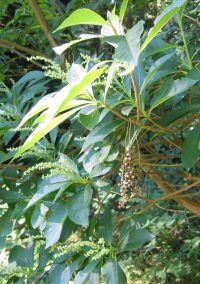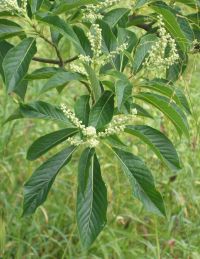Japanese clethra, (Tree clethra)) - Clethra barbinervis
English name:
Japanese clethra, (Tree clethra)
Scientific name:
Clethra barbinervis
Family:
Clethraceae (Sweet-pepperbush (White-alder))
Height:
5 M in Hørsholm after 30 years
Flowering:
early August
Range:
China, Korea, Japan
 |
|
 |
 |
TheClethra barbinervis plant in the pictures is from seed collected by the Nordic Arboretum Committee expedition to Japan in 1976. The seed was collected on Mt. Hikosan on the island Kyushu. They can be found in square 1011 positions 207 to 709 by a trail boarding the Salix collection. A map with squares and positions can be found on our homepage under: Plant search.
Plant description:
The genus Clethra is composed of about 64 species. Most are tropical and come from the Western hemisphere or East Asia. However there are several temperate species with deciduous leaves. One species, Clethra aborea, occurs naturally on the island of Madera. The family Clethraceae is closely related to Ericaceae. The genus name is derived from the old Greek word for alder because the leaves can be similar in shape to alder leaves. The arboretum currently has living examples of 3 different species within this genus.
My favourite among these three species is Clethra barbinervis. We have 17 examples of Clethra barbinervis in the Arboretum. Ten are from seed collected in the wild on Mt. Hikosan on the Island of Kyushu, Japan during the Nordic Arboretum Committees expedition in 1976. One single example is from Mt. Kamegamori on Shikoku. It was collected on the same expedition. Many species from the Japan expedition were also sent to a number of other places. This species was sent to: Copenhagen Botanic Garden, Århus Botanic Garden, Hornum Experimental Station in Denmark, as well as Swedens Agricultural University at Alnarp and the Gothenburg Botanic Garden in Sweden.
Clethra barbinervis was introduced into European cultivation in 1870. It was grown by the nurseryman Aksel Olsen in 1931, and tried in Hørsholm as early as 1955. Our oldest living plants are from 1977.
Clethra barbinervis (Ryoubu in Japanese) has eatable young leaves. The hard, dense, wood has been used for making charcoal, turnery and utensils and for alcove-posts with bark. It is mostly used however as an ornamental plant. In it native habitat it occurs in sunny places such as on ridges in the mountains of the temperate zone.
These are large deciduous shrubs or small trees that reach about 10 m in height in Japan. The habit of the plants is described as being pagoda, or candelabra-shaped. Like other species in the genus Clethra the bark is smooth and flaky. The leaves are alternate, and generally gathered at the end of shoots. They are broadly oblanceolate to obovate in shape, with a drawn out tip, toothed margins. They have a narrowly, wedge-shaped base. The upper surface of the leaf is deep green (if the soil is not too alkaline) and the lower surface is light green. The species name barbinervis refers to the bearded veins (hairy veins) of the leaves. One has to look closely to see these hairs in August. The flowers are fragrant and occur in horizontally-nodding, many-flowered. terminal racemes. The petals are clearly separated into 5 lobes. The fruits are 3-valved capsules with a persistent calyx. They contain many flattened seeds.
Clethra barbinervis forms a handsome smaller flowering tree or large shrub. Its distinctive candelabra-like branching habit, handsome foliage, late summer flowering (fragrant) make the best forms an excellent garden plant for acid soils. The colour of the foliage in the autumn is striking. The attractive flaking bark makes it a useful plant for the winter garden. This species is reported to resist deer browsing. It is relative disease free, but can suffer from winter damage. Our plants do not flower vigorously every year, but judging from the large number of flower buds, this year will be a major flowering year. Clethra barbinervis was recommended in the Arboretums Guide published in 1994 as a potential garden plant, and it has received a Royal Horticultural Society Award of Garden Merit. Some named cultivars are reported like 'Takeda Nishiki', and Dwarf, but there are many more named cultivars for the related Clethra alnifolia
References:
Bean, W.J. 1976 Trees and Shrubs Hardy in the British Isles Vol I. A-C Eight edition. John Murray publishers. 845 pp.
Jensen, N. 1994. Guide til Arboretet i Hørsholm (Guide to the Arboretum in Hørsholm). Dansk Dendrologisk Årsskrift. 12:1-237.
Kurata, Satoru. 1974. Illustrated Important Forest Trees of Japan Vol 2. (2nd edition) Chikyusha Co. Ltd. Tokyo. 265 pp.
Lange, J. 1999. Kulturplanternes Indførselshistorie i Danmark indtil midten af 1900-talet. (Introduction History of Cultivated Plants in Denmark up to the middle of the 20th century). DSR Forlag, Frederiksberg C. 458 pp.
Mabberley, D.J. 1998. The Plant Book. The Bath Press, Bath, 858 pp.
Olsen, O. et al. 1997 Havens Planteleksikon. Træer og Buske. (Danish Plant Encyclopedia, Trees & Bushes). Det Danske Haveselskab Publisher, 674 pp.
Poor, J.M. & Brewster, N.P. 1996. Plants that merit attention. II. Shrubs. Timber Press Inc. Portland.
Nice photographs:
